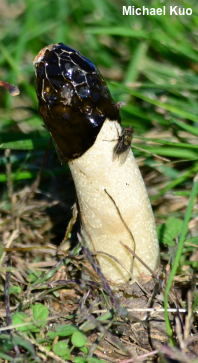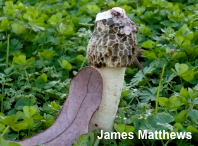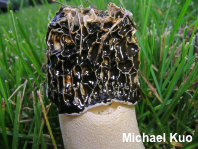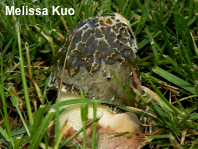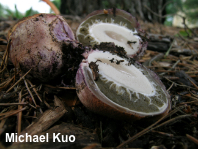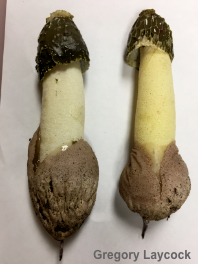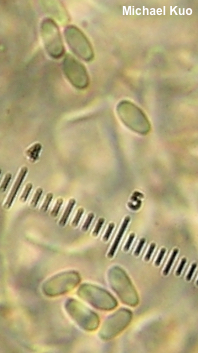| Major Groups > Stinkhorns > Phallus impudicus |

|
Phallus impudicus [ Basidiomycota > Agaricomycetes > Phallales > Phallaceae > Phallus . . . ] by Michael Kuo Stinkhorns are astonishing. Their abrupt appearance in gardens and lawns is frequently the cause of considerable consternation; they arise from an "egg" that results from the immature mushroom's universal veil, quickly breaking the "shell" and thrusting themselves up to heights of nearly 10 inches in a matter of hours! Phallus impudicus is like the Ur-stinkhorn. First described by Linnaeus in 1753 (see the protologue), as a "shameless phallus," it is indeed quite phallic and shameless. Like other stinkhorns, it covers itself with a foul smelling and spore-laden goo; flies are attracted to it, and carry the spores away as they continue on their little fly adventures. Stinkhorns have been much maligned over the years, perhaps because, like Scleroderma polyrhizum, they often appear where we don't want them: in the sterile botanical fortresses we try to maintain as our "yards" and "gardens." But unlike Scleroderma polyrhizum or dandelions, stinkhorns are extremely phallic, thrusting botanical invasion psychology into realms best analyzed by Freud. Your neighbor, stalking dandelions with a hand trowel every morning, is apparently no match for Etty Darwin (granddaughter of Charles), who "so despised stinkhorns that she mounted an antifungal jihad with the aid of gloves and a pointed stick," burning the stinkhorns in secret to protect "the purity of thought among her female servants" (Money, p. 3). Older Phallus impudicus specimens are occasionally mistaken for yellow morels. After the spore-bearing slime has been picked clean by insects, the pitted and ridged surface of the cap can resemble the cap of a morel. Since stinkhorns are hollow, and since the smell is not always as foul as it frequently is, it's easy to see why misidentification occurs. However, stinkhorns typically grow in summer, rather than spring—and a close examination will usually reveal traces of the slime. Phallus hadriani is . . . well, an uncertain entity. The name has been variously applied between decades, centuries, and continents. In North America the name has often been used to describe, more or less, Phallus impudicus with a purplish, rather than whitish to yellowish, volva—but this interpretation of Phallus hadriani is clearly erroneous, and the volva of Phallus impudicus varies in color from purplish to pinkish, yellowish, or whitish. See the linked page for a full discussion. Thanks to Lesley Bergemann, Roger Heidt, Gregory Laycock, and James Matthews for documenting, collecting, and preserving Phallus impudicus for study; their collections are deposited in The Herbarium of Michael Kuo. Description: Ecology: Saprobic; growing alone or gregariously in gardens, flowerbeds, meadows, lawns, woodchips, and cultivated areas (also appearing in woods, in Europe); spring through fall, or over winter in warmer climates; originally described from Sweden; widely distributed in North America and Europe; also reported from Central America, South America, and Asia. The illustrated and described collections are from Arkansas, Iowa, Illinois, Michigan, and Wisconsin. Immature Fruiting Body: Like a whitish to purplish "egg" 3–6 cm high and 2.5–4 cm wide; egg-shaped or nearly round; base attached to white to purplish rhizomorphs; when sliced revealing the whitish stinkhorn-to-be encased in a brownish gelatinous substance. Mature Fruiting Body: Cylindric and phallic, with a clearly differentiated head structure that sits atop the stem. Head: 3–6 cm high; conic, broadly conic, cylindric with a rounded apex, or somewhat truncated; becoming perforated at the apex, with the perforation surrounded by a sterile whitish "lip"; pitted and pocketed in a reticulate pattern; surface whitish, but covered with a thick layer of dark brown spore slime; undersurface of head whitish, not covered with spore slime. Stem: 7–11 cm high; 2–3 cm thick; fairly equal above, but tapered sharply at the base; dry; white to whitish; finely pocketed with 1–3 chambers per mm; hollow; base enclosed in a whitish, brownish, purplish, or reddish brown volva 3–5 cm high; attached to white or purplish rhizomorphs. Flesh: 2–5 mm thick; whitish; minutely chambered. Odor: Unpleasant and strong. Chemical Reactions: Iron salts negative on all surfaces. KOH negative on all surfaces. Microscopic Features: Spores 3–4 x 1–1.5 µm; subcylindric; smooth; without oil droplets; hyaline in KOH. Sphaerocysts of the pseudostipe 30–70 µm; irregularly subglobose; smooth; walls 0.5–1 µm thick; hyaline in KOH. Hyphae of the volva 2–6 µm wide; smooth; thin-walled; hyaline in KOH; clamp connections present. Hyphae of the head composed of chains of inflated cells 10–30 µm wide; terminal cells subglobose to widely cylindric; smooth, thin-walled, hyaline in KOH. REFERENCES: Linnaeus, 1753. (Scopoli, 1771; Fries, 1823; Saccardo, 1888; Long, 1907; Coker & Couch, 1928; Phillips, 1981; Smith, Smith & Weber, 1981; Saenz & Nassar, 1982; Breitenbach & Kränzlin, 1986; Weber & Smith, 1985; Arora, 1986; States, 1990; Phillips, 1991/2005; Horn, Kay & Abel, 1993; Kreisel, 1996; Calonge, 2005; Calonge et al., 2005; Hosaka et al., 2006; Kibby, 2006; McNeil, 2006; Miller & Miller, 2006; Kuo, 2007; Nonis, 2007; Kreisel & Hausknecht, 2009; Giachini et al, 2010; Hosaka, 2010; Buczacki et al., 2012; Kuo & Methven, 2014; Sandoval-Leiva et al., 2014; Trierveiler-Pereira et al., 2014; Desjardin, Wood & Stevens, 2015; Evenson, 2016; Gminder & Böhning, 2017; Woehrel & Light, 2017; Wood & Dunkelman, 2017; Læssøe & Petersen, 2019.) Herb. Kuo 06100401, 09220801, 05081201, 05141201, 01081602, 01081603, 10041601, 09281801. This site contains no information about the edibility or toxicity of mushrooms. |
© MushroomExpert.Com |
|
Cite this page as: Kuo, M. (2021, March). Phallus impudicus. Retrieved from the MushroomExpert.Com Web site: http://www.mushroomexpert.com/phallus_impudicus.html |
